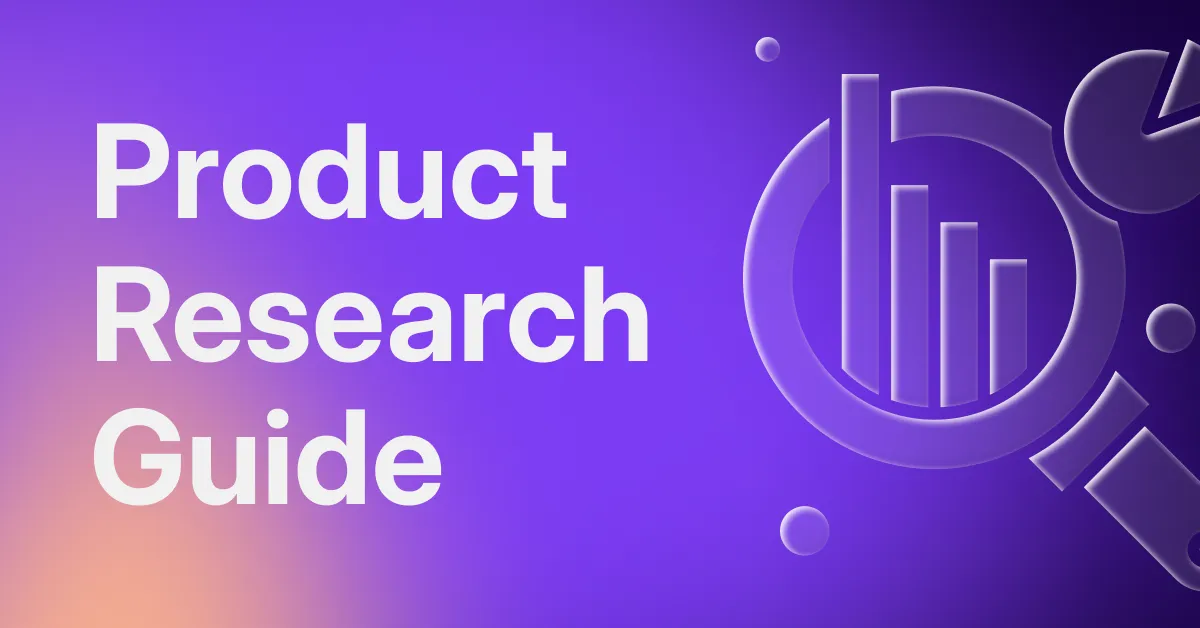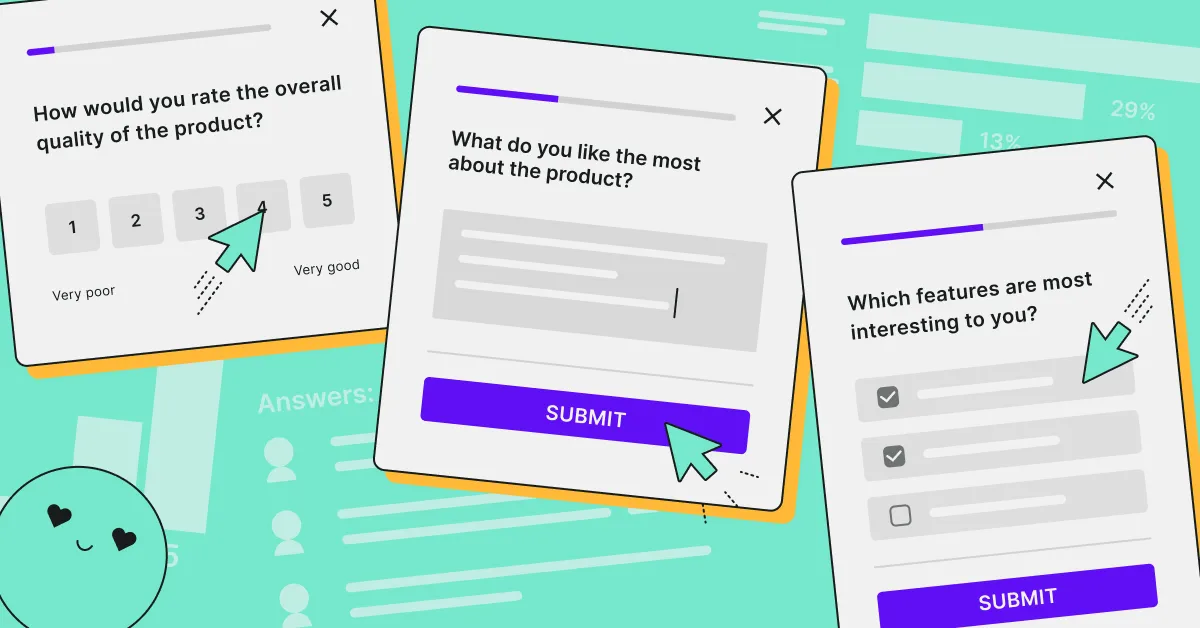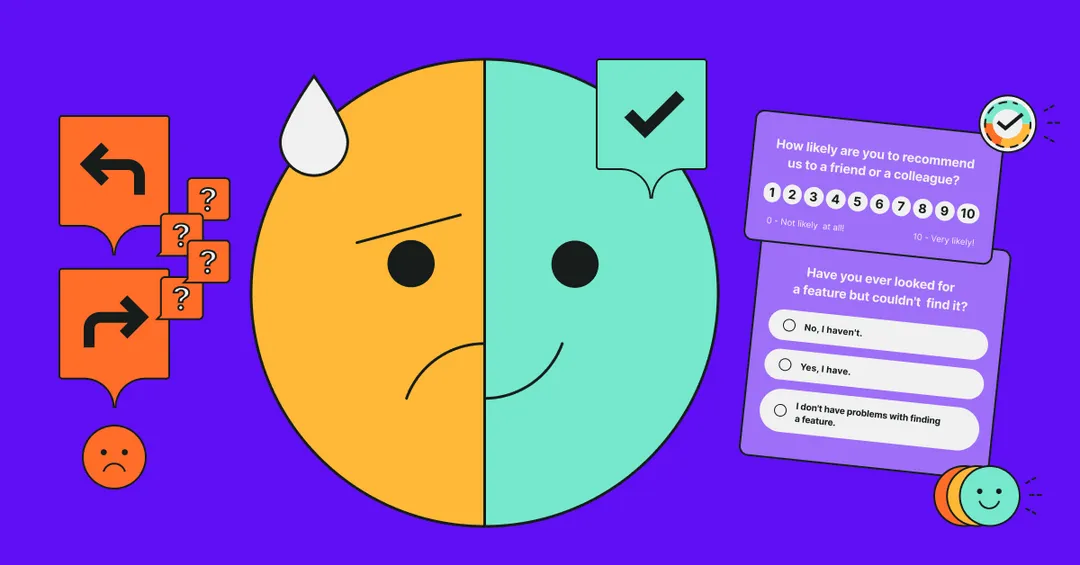Tl; dr;
- Empathy is Essential: Truly understanding and empathizing with users is at the heart of user-centered design. It's about more than just observing behaviors; it's about immersing in the user's world to create intuitive and user-friendly products.
- Feedback Fuels Design: Survey tools like Survicate effectively collect user feedback. Integrating it is not just beneficial; it's critical. Feedback directly shapes the user-centered design, ensuring the final product meets user expectations and improves with each iteration.
- Iterative Improvement: User-centered design is an iterative process. Continuous refinement based on user feedback leads to products that are increasingly aligned with user needs and provide a better experience.
- User Satisfaction and Loyalty: A product users find satisfying and aligned with their needs increases customer loyalty. User-centered design helps create a positive digital journey that encourages users to return and recommend the product to others.
- Balancing User Needs and Feasibility: Successful user-centered design requires balancing user desires and practical constraints. It’s about creating the most user-friendly product possible within technical, budgetary, and time limitations.

User-centered design (UCD) isn't just about making things look pretty; it's a strategic approach that puts on a user's shoes and walks around in them.
This article explores how human-centered design enhances user experience, helping you craft functional and delightful solutions. By reading on, you'll discover the 'whys' and 'hows' of UCD and learn how to apply its principles to delight your users and meet your business goals.
What is user-centered design?
User-centered design (UCD) is a creative approach where the end-user needs, preferences, and limitations are given extensive attention at each stage of the iterative design process.
This philosophy emphasizes that the primary goal is to enhance the overall user experience by making products and systems more accessible, understandable, and usable. A user-centered design approach involves users throughout the product development lifecycle through various research and design techniques. You want to ensure that their desires and requirements shape the final outcome.
The process is iterative and involves continuous improvements based on user feedback and behavior. User-centered design is grounded in deeply understanding the users' characteristics, tasks, environment, and goals.
User-centered design principles
Empathy for the user
Understanding the users' emotions, experiences, and motivations is crucial. You must immerse yourself in their environment to grasp the context of their interactions with the product.
Your design approach should prioritize users’ needs and preferences, ensuring the product feels intuitive and easy to use.
User feedback
Incorporating user feedback directly informs the design decisions to meet your user's expectations.
Your UCD process should include collecting feedback through user research interviews, surveys, or usability tests and then applying this feedback to refine product designs.
Iterative process
User-centered system design is an ongoing process requiring you to create multiple product iterations based on user feedback. Your design should evolve over time, progressively improving each cycle and enhancing the user experience.
By focusing on these principles, you can develop products offering a superior, user-friendly experience.
What are the benefits of user-centered design?
When you integrate user-centered design principles into your development process, you reap tangible benefits in user satisfaction, accessibility, and usability.
Better user satisfaction
By placing your users at the forefront of your design process, you ensure that the final product closely aligns with their expectations and needs. This alignment often increases customer loyalty and repeat usage due to users' positive product experiences.
Improved usability
A core outcome of user-centered design is the enhancement of a product's usability. Regularly testing with real users ensures that your product is intuitive and efficient, leading to reduced training costs and higher productivity. This iterative testing phase helps identify and rectify any usability issues early on, saving you time and resources in the long run.
Increased accessibility
By considering a diverse range of abilities and needs during the design process, user-centered design helps create products accessible to a broader audience, including those with disabilities, thereby expanding the user base.
Enhanced efficiency
Products designed with the user in mind require less time to learn and master. This efficiency translates into faster completion of tasks, which can be especially beneficial in a professional context where time is critical.
Reduced development costs
Incorporating user feedback early and throughout the user-centered design process can identify potential issues before they become costly. This proactive approach can reduce the need for major changes later on, which can be expensive and time-consuming.
Customer loyalty
Users who feel a product meets their needs and expectations will likely become repeat customers. User-centered design can foster loyalty by creating a positive experience that users want to return to and share with others.
Four steps of user-centered design
User-centered design is a process tailored around the users, ensuring the final product meets their needs. Here's a breakdown of the core stages.
1. Understand the context of use
You begin by comprehensively analyzing the environment in which the user will interact with your product. This includes understanding the user's tasks, goals, motivations, and the physical and social environments that may influence how they engage with the product.
2. Gather requirements
Next, you focus on collecting detailed user and business requirements. This is not a one-time event but an ongoing process where you identify the product's necessary features, capabilities, and constraints from the user's perspective.
3. Design solutions
Armed with actionable insights, you now create design solutions. This phase involves generating multiple design ideas, prototyping possible solutions, and refining them through iterative cycles with user involvement at each step.
4. Evaluate and test
Finally, you evaluate the design process solutions against the user's requirements. This involves usability testing, where you observe users interacting with your product, collecting product feedback, and making evidence-based decisions to refine the product further.
This structured UCD approach ensures your product is functional, user-friendly, and tailored to the needs of your target audience.
Methods and tools for the UCD process
In user-centered design, you will find a suite of methods and tools specifically tailored to understand and meet customer needs. Utilize these resources effectively to ensure the success of your design.
User interviews and surveys
User interviews and surveys are essential to gain valuable insights into user personas' behaviors, needs, and motivations. Through interviews, you engage in direct conversation with users, allowing for a deep dive into their experiences and opinions.
On the other hand, surveys enable you to quickly collect data from a larger pool of users, often yielding more quantitative data.
Interview techniques:
- Open-ended questions
- Follow-up inquiries for clarity
Survey strategies:
- Multiple-choice for quantifiable data
- Likert scales to measure attitudes

User personas and scenarios
Creating a user persona is a method to represent a group of users based on research to guide your design decisions by providing a clear picture of the user's goals and behaviors. You can create multiple personas to represent your target users better.
Scenarios then put this user persona in context by outlining hypothetical situations, how a persona interacts with your product, and the challenges they encounter.
Persona elements:
- Demographics
- Behaviors
- Goals
Scenario development:
- Typical tasks the user performs
- User's environment and context
Usability testing
Usability testing is critical to user-centered design, where actual users test your product to assess its usability.
It involves observing users as they complete tasks and helping you identify usability issues before the product is launched. Feedback is gathered in real-time, providing actionable insights into enhancing your product's user experience.
Usability testing methods:
- Think-aloud protocol
- Task completion and time tracking
Prototyping tools
Incorporating prototyping tools into your UCD process lets you quickly create and iterate on product models. These tools facilitate testing design concepts without full development, saving time and resources.
Common prototyping tools:
- Sketch
- Adobe XD
- Figma
- InVision
By carefully applying these methods and tools, you will refine your product in a way that resonates with your users.
Best Survey Types for the UCD Process
Selecting the right survey type is crucial for gathering meaningful user feedback during the user-centered design process. Here are the most effective surveys to enhance your product's user experience.
Net Promoter Score (NPS) surveys
NPS surveys are a straightforward tool for measuring how likely users are to recommend your product or service to others. This feedback can strongly indicate overall user satisfaction and the product's success in generating positive word-of-mouth.
Customer Satisfaction (CSAT) surveys
CSAT surveys ask users to express their satisfaction with your product or service. Typically, they answer using a scale, which provides a clear metric to assess user happiness and areas that may require enhancement.
User Experience (UX) surveys
UX surveys delve into how users interact with your product, focusing on its usability, design, and overall functionality. They often include detailed questions on various UX elements to help pinpoint specific areas needing improvement.
Customer Effort Score (CES) surveys
CES surveys measure a user's effort to utilize your product or service or solve a problem. Understanding the level of effort helps pinpoint and reduce friction points, thereby streamlining the user experience.
Utilizing these surveys in the user-centered design process can provide invaluable insights into how real users interact with your product or service. You can create a more user-friendly and successful product by understanding and acting upon user feedback.
Challenges in user-centered design
User-centered design (UCD) requires careful consideration throughout the development process. While the approach offers considerable benefits, you'll encounter specific challenges that can impact the outcome of your projects.
Resource allocation
Allocating the necessary resources is critical to user-centered design, with time and budget being the primary concerns.
You must ensure sufficient time is invested in user research to understand their behavior, needs, and preferences. Likewise, based on this feedback, an appropriate budget must be allocated to gather insights and iterate on the product.
Stakeholder alignment
Securing stakeholder alignment can be challenging, as not everyone might appreciate the value of a user-centered approach.
To align stakeholders, you have to communicate the benefits clearly and demonstrate how UCD leads to products that are more likely to satisfy user requirements and, as a result, achieve business goals.
Design constraints
You will have to negotiate between user needs and technical feasibility, as well as time-to-market pressures.
Finding a balance between creating a user-friendly product and adhering to technical constraints or organizational limitations is essential for a successful design that is both practical and appealing.
Level up your user-centric design with Survicate
User-centered design is not just a methodology but a commitment to creating experiences that resonate deeply with the end-users. It's about actively engaging with the people who will use your products and shaping those products around their feedback and needs.
Survicate survey software is particularly effective for gathering the actionable insights necessary to drive a successful design process.
With its ability to conduct various surveys—like NPS, CSAT, UX, and CES—Survicate offers a comprehensive suite for collecting user feedback.
As you look to enhance your product's user experience, consider the measurable benefits that Survicate can provide in understanding and meeting your users' needs. Embark on a journey towards a more user-focused design by trying Survicate for free.
Start your 10-day trial today, with access to all the Business Plan features, and take the first step towards creating products that your users will love.
User-centered design FAQs
This section addresses common inquiries about user-centered design, providing a foundational understanding of its principles, practices, and impacts.
What are the key principles that define user-centered design?
User-centered design is grounded on understanding user needs and preferences. The key principles include understanding user contexts, involving users throughout the design process, and iterating designs based on user feedback.
Can you provide some examples of successful user-centered design in practice?
Successful examples include Apple's iPhone, which revolutionized smartphone interfaces with its intuitive design, and the Google search engine, which is consistently refined to cater to users' seeking information.
How does user-centered design differentiate from human-centered design?
User-centered design focuses specifically on the product's users, while human-centered design considers a broader spectrum of human experiences and social impacts when designing solutions.
What are the essential stages or steps involved in the user-centered design process?
The essential steps in the user-centered design process typically involve research to understand the user, ideation to develop potential solutions, prototyping, testing with users, and refining the design based on feedback.
What elements are crucial to consider when creating a user-centered design architecture?
Crucial elements include accessibility, usability, and the incorporation of user feedback into the design of the architecture, ensuring that it aligns with user behaviors, needs, and expectations.
How has user-centered design been integrated into the development processes at major companies like Google?
At companies like Google, user-centered design is integral to product development. They conduct extensive user research, employ A/B testing, and constantly iterate their products based on user data and feedback.













.webp)
.webp)
.svg)

.svg)



